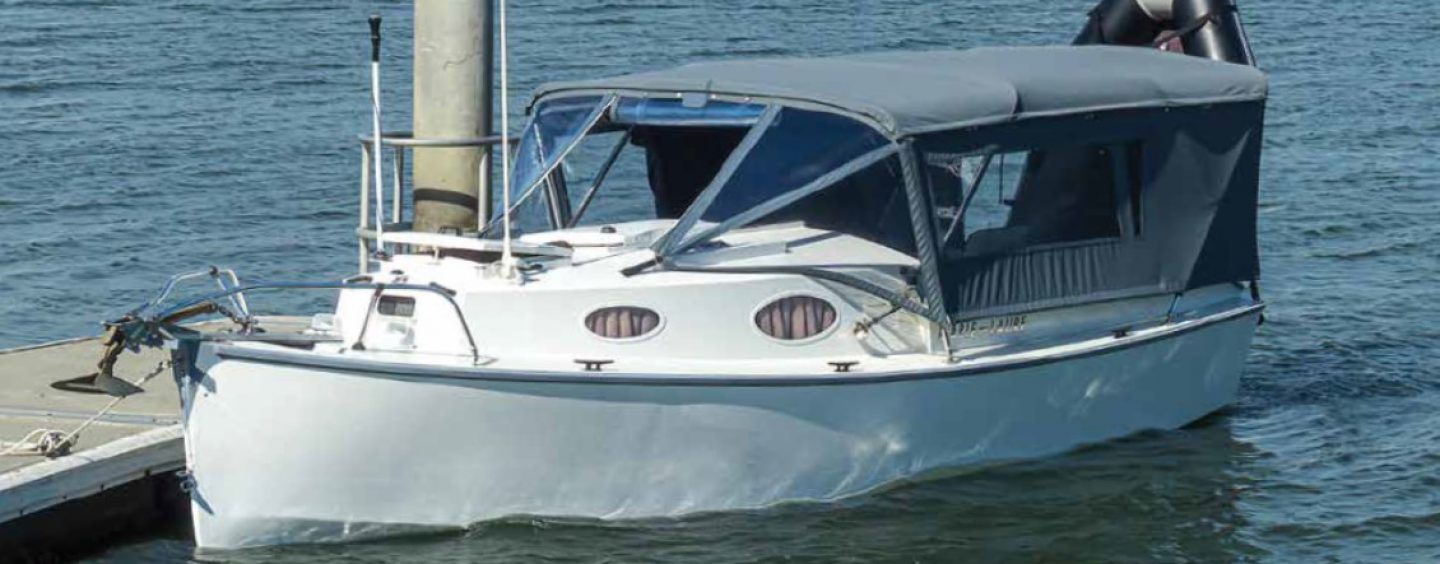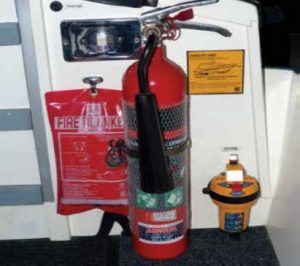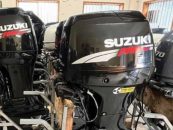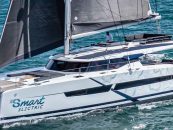What Every Boat Owner Should Know
By Arthur Marcel
Portable fire extinguishers of many different kinds, using various propellants and fire suppressing agents, have been around for a century or two. In Australia today, however, there are only about six kinds approved for general use, just one of which is in regular private use.
Most privately owned extinguishers are the ABE powder type. These are readily available, cheap and effective. However, they have two serious drawbacks.
ABE extinguishers are identified by a white band (see photo left) at the top, while CO2 extinguishers have a black band. The first drawback with ABE powder extinguishers is that they make a mess. In September 2021, while holidaying with my wife at the Gold Coast on our boat, we over-primed the stove and set fire to the cockpit. I extinguished the fire with an ABE extinguisher, but it took two days and a trip back to Brisbane with a load of washing to fully clean fine black powder out of cockpit and cabin, and resume our holiday.
After this experience, I started investigating alternative types of extinguishers. I was particularly keen to know more about carbon dioxide. The professional advice I received was that for hard (non-absorbent) surface fuel fires, the kind we had experienced, CO2 is perfect, every bit as good as ABE powder. They are not so good, however, at putting out deeply-seated fuel fires where the fuel has been absorbed into a substrate like unsealed wood, cardboard, paper or canvas. This is because they extinguish the fire in just two ways, firstly by temporarily depriving it of oxygen and also by cooling the fuel below flash point. In a deeply-seated fire there is always the risk of re-ignition as the CO2 (unlike ABE powder) dissipates and the ambient air puts heat back into the material. But there is no mess.
The second drawback of ABE powder applies to boats made from metal, particularly aluminium alloy. ABE powder reacts with aluminium. If sprayed on an untreated (that is, unpainted) aluminium surface, it will quickly disfigure that surface and cause a degree of structural weakening depending on the time it is left in contact with that surface. It can also have a deleterious effect on electrical terminals, exposed wires and switches.
While not exactly a drawback, a third issue with ABE extinguishers is that they need regular servicing. While CO2 units only require a periodic weight check, ABE units need active rejuvenation every six months or so (in addition to checking their pressure gauges). This is because the powder tends to clump at the bottom of the canister blocking the exit tube and, over time, this clumpiness can prevent proper egress when the valve is actuated. The solution is to tap the base of the canister with a rubber mallet and then up-end the extinguisher to assess a change in balance resulting from the powder flowing from one end to the other.
Furthermore, unlike powder extinguishers, CO2 units have no pressure gauge. With suppressant and propellant being one and the same, serviceability is easily assessable by weight, clearly a more reliable method than a cheap gauge. A fully loaded 2 kilo capacity unit should come in at just over 5 kilos (3 kilos when spent).
CO2 extinguishers have an operating pressure of over 50 Bar, more than twice the pressure inside a powder extinguisher. This means they need to be of more robust construction, typically with a wall thickness of 5mm compared to less than half that for powder. They are also of seamless, fully blown, aluminium alloy construction, with no base weld. This is a distinct advantage in marine environments. It is extremely rare for a CO2 extinguisher to fracture and all known past failures have been associated with very obvious external corrosion at the base of the container. As well, the trigger mechanisms contain a ‘burst disc’ which is designed to vent the contents if pressure exceeds tolerances, as might be the case if the unit was left in a fire.
Both ABE and CO2 extinguishers are one-use-only devices. With ABE, as soon as the powder starts to flow, even for the shortest time, the valve will not close perfectly and the propellant (Nitrogen) will leak away after just a few hours. With CO2 units, the trigger mechanism minutely punctures the burst disc, thus very slowly venting (may take weeks, even months) the contents after any usage.
It needs to be noted that CO2 is less dense than ABE, so the extinguishers are just a bit larger for the same weight. However, this was a minor issue for me and CO2 was the only way to go. I now have a 2 kilo CO2 extinguisher in my boat and a 3.5 kilo unit under my house. I feel confident of being able to handle future fire emergencies with this type of extinguisher. Hopefully, though, there won’t be any.
Finally, it is very important that everyone onboard be trained to use the fire extinguisher. My wife actually started that fire, and she had no idea how to use the extinguisher. If I hadn’t been there, we would probably have lost the boat or even worse. Ever since, she has been doing a fire drill at least once per holiday.
Published in print January-March 2023





























